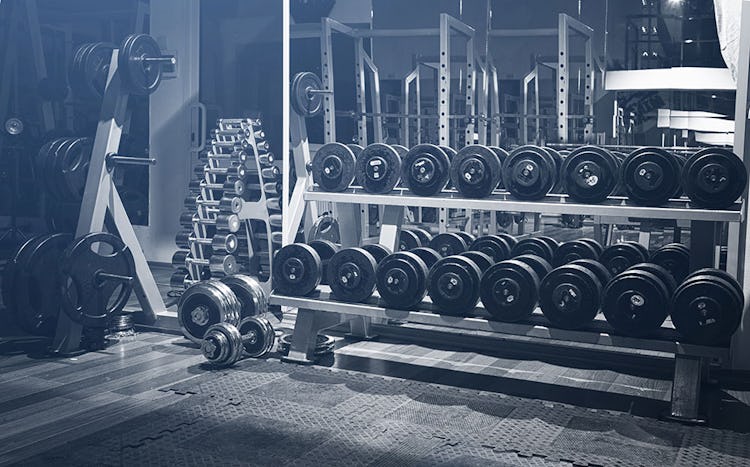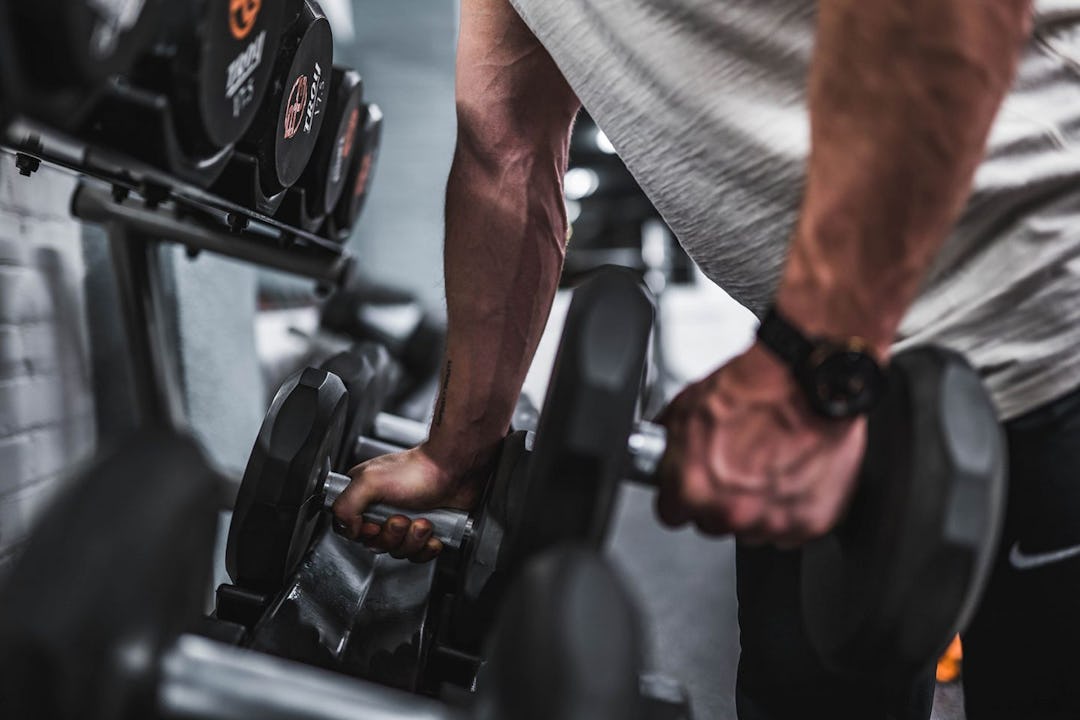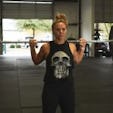Summary
– Dumbbells provide several advantages, including freedom of motion, the ability to correct strength imbalances, safety, and stability.
– Some of the best dumbbell exercises include the paused squat jump, Bulgarian split squat, step-over lunge, Romanian deadlift, single-leg kickstand wall RDL, lateral lunge with reach, front-foot elevated split squat, and goblet squat.
– Dumbbells can be used to add muscle size, strength, power, and mobility to the legs.
A Pro’s Guide To Dumbbell Leg Exercises and Workouts
There aren’t too many things from 700 B.C. that are still in style, but dumbbells are an exception. The use of dumbbells, specifically for leg training, dates back to at least ancient Greece. Records show that athletes swung stone implements while they practiced jumping drills, using the extra weight to add momentum to their leaps. Later, the term “dumbbell” was coined in the 1700s in England, and then migrated to the U.S. where, it appears, the Founding Fathers started clanging and banging. In letters to his son, Benjamin Franklin wrote, “I live temperately, drink no wine, and use daily the exercise of the dumbbell.” (He claimed to have performed a workout consisting of 40 swings.)
Hundreds of years later, dumbbells are still accessible, versatile, relatively easy to use, and highly effective for helping you build muscle, strength, and athleticism. If they were good enough for Spartan warriors and the guy on the $100 bill, they’re good enough for you and me.
I like dumbbells for all kinds of training—especially lower-body work—and if they’re all you’ve got due to your gym being closed or out of your budget, you’d better learn how to make the most of them. Here, I’ll share my favorite dumbbell leg exercises, and give you a workout that ties them all together to build muscular, strong legs that are also capable of explosive speed and agility.
What Are the Benefits of Working Out My Legs with Dumbbells?

Dumbbells offer many advantages over barbells, machines, and other implements for training the legs. Here are some key benefits.
Greater Freedom of Motion
When you use a barbell, the weight is fixed in one position. That can be a problem if you have injuries, or lack flexibility. Dumbbells allow you to adjust where the weight is in relation to your body, and that can let you customize your exercises to perform them more safely.
Take Romanian deadlifts, for example. Using a barbell, the weight moves down the front of your body to your shins as you bend your hips back. The load is displaced in front of you, and that puts a lot of stress on your lower back. With dumbbells, you have the freedom to hold the load further back, closer to your sides and your center of gravity. This keeps more of the stress on the hamstrings where you want it, and less on the low back.
Correction of Strength Imbalances
When you use barbells and machines, it’s difficult to recognize strength imbalances between sides. The strong limb will compensate for the weaker one, and you won’t notice which leg is lagging behind the other. Over time, failing to correct this imbalance can lead to injury.
Dumbbells lend themselves well to unilateral training—working one limb at a time. Lunges, split squats, and single-leg RDL’s are all more practical and user-friendly to do with dumbbells versus other equipment, and they make you aware of your restrictions, both in terms of range of motion and strength. Training one leg at a time, you’ll see which side needs more work, and you can begin to even things out. Unilateral training also allows you to work with greater ranges of motion (you can typically go further down on a single-leg RDL or squat than you can on the two-legged versions), and it’s more in line with how we move in real life—balancing, landing, and pushing off from one leg at a time rather than both together. Get strong unilaterally, and you’ll almost certainly be stronger when you use both legs at once.
Increased Stability
It’s hard to balance on one leg, so unilateral dumbbell training builds more stability than training bilaterally. This alone can go a long way toward helping you break through muscle and strength plateaus.
When your joints lack stability, your brain recognizes it, and won’t allow you to produce the maximum amount of force that you’re capable of. Essentially, it puts the breaks on to prevent you from hurting yourself. In that sense, dumbbell training plays a big role in unlocking your potential to grow from all the training you do.
Greater Safety

With any exercise tool you use, you have to be aware of your body and focus on proper form when you train. But dumbbells are inherently safer than barbells. A) They offer greater freedom of motion (explained above). B) They don’t allow you to train as heavy, and C) they’re easy to let go of if you get in trouble. Hang around a gym long enough and you’re bound to see somebody get stuck at the bottom of a barbell back squat and need to be helped up. But if you can’t complete a rep with dumbbells, you can bail out by simply dropping the weights to the floor. For anyone training at home alone, dumbbells are a must.
Joint-Friendy Training
Whether it’s back squats, deadlifts, or their many variations, barbell leg exercises tend to put a lot of compression and shear forces on your spine. If your form isn’t pristine, the risk of injury goes up dramatically, and many people have mobility and stability limitations that prevent them from doing these lifts safely.
Dumbbell leg exercises don’t load the spine directly. Furthermore, because they’re conducive to safer training, you’ll feel more confident pushing yourself further without fear of your form breaking down. This can mean more intense workouts and faster gains.
What Leg Exercises Can I Do With Dumbbells?
Now I’ll introduce you to eight of my favorite dumbbell leg exercises (Onnit only asked me for five, but I couldn’t help myself!). Together, they cover the gamut of training goals. Some are for straight-up leg mass, and others help to build explosiveness and athleticism. Many of them will really stretch your hamstrings, hips, and adductors, too, expanding your mobility so you can achieve greater ranges of motion in all your lower-body movements and activate more muscle.
*All videos courtesy of Luka Hocevar and Vigor Ground Fitness
#1. Dumbbell Paused Squat Jump
This one is great for developing explosive power and the ability to decelerate your body after a jump or sprint. I use it often with the basketball players I train.
Step 1. Hold a dumbbell in each hand and stand with feet about hip-width apart. Keep your arms locked out and think about squeezing oranges in your armpits to keep the lats under tension.
Step 2. Retract your neck so your head isn’t sticking out in front of your body (think: “packed chin”). Your head, spine, and pelvis should form a long, straight line. Brace your core.
Step 3. Squat down until your knees are bent about 90 degrees (think: “half squat,” not a full squat). The dumbbells should be just outside your legs but not touching them.
Step 4. Pause a second at the bottom, and then explode upward. Apply as much force to the ground as possible, and imagine trying to touch your head to the ceiling.
Step 5. Land like a ninja—with soft knees, and as quietly as you can. Push your hips back as you touch down to help you decelerate. Think about it like this: if you were landing in a puddle, how would you do it so as not to make a huge splash?
Make sure you pause between reps to reset yourself as needed.
#2. Dumbbell Bulgarian Split Squat
One of my favorite lower-body exercises, the split squat builds strength, muscle, and stability that transfers over to athletic movements. It also supports gains on big barbell lifts like the deadlift and squat.
Step 1. Stand lunge-length in front of a single-leg squat stand (shown here) or bench. Hold dumbbells at your sides and rest the top of your back foot on the bench. Your back leg should be bent about 90 degrees (use this leg as little as possible throughout the exercise; you should feel almost no tension in it). Keep your arms locked out and think about squeezing oranges in your armpits to keep the lats under tension.
Step 2. Retract your neck so your head isn’t sticking out in front of your body (think: “packed chin”). Your head, spine, and pelvis should form a long, straight line. Brace your core.
Step 3. Hinge your hips back so your torso is angled forward, and lower your body until your rear knee is just above the floor. As you descend, your spine and shin should run parallel to each other.
Step 4. Think about pushing the floor away from you and feeling your whole foot contact it as you come back up to the starting position. Be careful not to fully lock out your front knee—it should be slightly bent at the top of each rep. Complete your reps on that side, and then switch sides and repeat.
#3. Dumbbell Step-Over Lunge
Looking for a “functional” exercise? How about one that works deceleration, acceleration, coordination and just about every muscle in the lower body? The step-over lunge is one of the most challenging lunge variations you can do, but once you’ve got it down, you’ll see huge results.
Step 1. Hold a dumbbell in each hand and stand with feet about hip-width apart. Keep your arms locked out and think about squeezing oranges in your armpits to keep the lats under tension.
Step 2. Retract your neck so your head isn’t sticking out in front of your body (think: “packed chin”). Your head, spine, and pelvis should form a long, straight line. Brace your core.
Step 3. Step backward with a slight hinge/lean in your hips so that you load your glutes. Control your descent, and softly touch the floor with your back knee.
Step 4. Drive through the floor with your front foot and step forward out of the lunge. Try not to put your foot down to rebalance yourself—just step straight into a forward lunge. Complete your reps on that side, and then switch sides and repeat.
Note: It’s OK if your knee travels in front of your toes at the end-range of a lunge. It’s not only safe, it’s actually healthy for the ankles, knees, and hips to develop stability in that range of motion.
#4. Dumbbell Romanian Deadlift
The RDL is the best way to teach a true hip-hinge movement, which is used in all sports and multiple daily activities. Starting the lift from the top rather than the bottom makes it safer, and the dumbbells help you keep the weight closer to your center of gravity than the barbell alternative.
Step 1. Hold a dumbbell in each hand at your sides and stand with feet about hip-width apart. Keep your arms locked out and think about squeezing oranges in your armpits to keep the lats under tension. Draw your shoulders back and down (think: “proud chest”).
Step 2. Retract your neck so your head isn’t sticking out in front of your body (think: “packed chin”). Your head, spine, and pelvis should form a long, straight line. Brace your core.
Step 3. Push your hips back like you’re trying to shut a car door behind you with your butt. Bend your knees slightly, and think about pulling yourself down with your hip flexors (the muscles on the front of your hips that raise your legs up) as you lower your torso. As you go down, allow the dumbbells to move slightly forward and around to the front of your thighs.
Go down until the dumbbells reach mid-shin level, or you feel a strong stretch in your hamstrings, and pause at the bottom. Your eyes should be looking about three feet in front of your toes. If you find yourself looking down at your feet or at the wall in front of you, your neck is out of alignment.
Be sure to keep your long-spine position. Don’t round your back.
Step 4. Extend your hips to come back up, and squeeze your glutes at the top of the rep.
#5. Dumbbell Single-Leg Kickstand Wall RDL
This is an incredible exercise for teaching great hinge form while putting the hip in abduction and internal rotation—skills that keep the hips healthy and athletic while also activating lots of glute muscle.
Step 1. Stand in front of a wall, facing away, and hold a dumbbell in your left hand. Bend the left knee, and push that foot back into the wall. Get a soft bend of the knee on the other leg. Draw your shoulder blades back and down, pack your chin, and get a long spine from your head to your pelvis.
Step 2. Bend your hips back while twisting your torso toward the right leg so that the dumbbell lines up in front of it. Think about getting your belly button to point at the outside of the knee. Go down until the dumbbell is at mid-shin level, or you feel a strong stretch in your hamstrings. Keep the left knee pulled in as you perform the RDL—don’t let it drift outward.
Be sure to maintain your long-spine position. Don’t round your back.
Step 3. Push the floor away as you come back up, and extend your hips fully. Complete your reps on that side, and then switch sides and repeat.
#6. Dumbbell Lateral Lunge with Reach
Most muscle-building exercises are done in the sagittal plane, where the movement occurs forward and back. Lateral lunges break you out of that groove, utilizing the frontal plane, which is so prominent in sports play. Fighters, football players, soccer players, and so on have to be able to move side to side without pulling a muscle or tripping over their feet. This move prepares them for it.
Step 1. Hold a dumbbell in your right hand and stand with feet about hip-width apart. Keep your arms locked out and think about squeezing an orange in your armpit to keep the lats under tension.
Step 2. Retract your neck so your head isn’t sticking out in front of your body (think: “packed chin”). Your head, spine, and pelvis should form a long, straight line. Brace your core.
Step 3. Lunge to your left side, making sure your left foot stays on the same plane as the right one. (Tip: do the exercise on turf, or some other area that has a line painted on it so you get some feedback. Placing a long exercise band on the floor can also work.) Make sure you step far enough so that you feel a stretch on the locked-out leg.
Step 4. Sit back into your hip (it’s a hinge/deadlift movement more than a squat), and make sure your knee aligns with your big toe on the left leg. If this is a problem, imagine pushing a $100 bill into the floor with the inside of your foot. As you lower into the lunge, twist your torso so you can nearly touch the dumbbell to your foot.
Step 5. Push off the lunging leg and come back to the starting position in one fluid motion. Complete your reps on that side, and then switch sides and repeat.
#7. Dumbbell Front-Foot Elevated Split Squat
I love this move for teaching a vertical squat pattern, where your hips and torso move straight down as opposed to more of a hip-hinge motion. This reduces shear forces on the spine. Most of my clients say their hips and low back feel great after doing these, even though their legs are on fire.
Step 1. Hold a dumbbell in your left hand and stand with your left foot on a weight plate or other platform that elevates it about two inches above the floor. Extend your right leg behind you. Keep your left arm locked out and think about squeezing an orange in your armpit to keep the lat under tension.
Step 2. Retract your neck so your head isn’t sticking out in front of your body (think: “packed chin”). Your head, spine, and pelvis should form a long, straight line. Brace your core.
Step 3. Rotate the hip of the rear leg forward so it’s square with the other hip, and begin sitting back into the hip that’s over the plate. Your rear thigh and knee must stay aligned with your right foot, so don’t let the knee turn inward when you rotate the hip.
Step 4. Actively drive your front foot into the plate, making sure your heel stays down, as you slowly lower your body until your rear knee is just above the floor. Stay as vertical as possible—think of your body like a canister. Your front knee will travel forward and you should aim to touch your hamstrings to your calf.
Step 5. Push off the front foot to raise your body back up. Think “elevator, not escalator,” so you push the plate away while staying vertical and not rising back on an angle. Rise until your rear leg is straight—your front leg should be well short of lockout.
#8. Dumbbell Goblet Squat
If you have trouble dialing in your squat form, the goblet squat is a great way to re-train yourself. It teaches you to stay upright and sink into your hips, and often leads to near-perfect squat mechanics right away. The goblet squat not only works your lower body, but requires a lot of strength and stability from your core and upper body as well. It’s great for reinforcing good posture when done correctly.
Step 1. Hold a dumbbell under your chin vertically, with both hands on the end of one bell. Stand with feet between hip and shoulder-width apart and turn your toes out about 30 degrees. Think about squeezing oranges in your armpits to keep the lats under tension. Draw your shoulders back and down (think: “proud chest”).
Step 2. Retract your neck so your head isn’t sticking out in front of your body (think: “packed chin”). Your head, spine, and pelvis should form a long, straight line. Brace your core.
Step 3. Drive your knees forward and pull yourself down into the squat using the hip flexors (the muscles on the front of the hips that raise your legs up). Stay as vertical as you can with your upper body, and go as deep as you can while keeping alignment from your head to your pelvis—your lower back should be neutral at the bottom (not rounded over or hyperextended). Your elbows should be able to touch the medial side of your knees in the bottom position.
Step 4. Push the floor away as you rise back up to stand tall.
Note: On all of the above exercises, it can help to think about keeping your ribs down. This means to avoid any hyperextension of your lower back that would cause your ribs to flare. If you focus on pulling the ribs down toward the pelvis, you’ll brace your core properly and create a neutral spine position. This promotes safety, and will ensure your legs work to the maximum.
What Muscles Will I Be Targeting?
The above exercises combined target every muscle group in the lower body (and a great many muscles in the upper body too, which provide stability), as well as the core. I’ll break down the major muscle groups targeted in each lift.
Dumbbell paused squat jump: glutes, quads, calves
Dumbbell Bulgarian split squat: glutes, quads, hamstrings, adductors
Dumbbell step-over lunge: quads, glutes, adductors
Dumbbell Romanian deadlift (RDL): hamstrings, glutes, spinal erectors, core
Dumbbell single-leg kickstand wall RDL: glutes, hamstrings, adductors, core
Dumbbell lateral lunge with reach: glutes, adductors
Dumbbell front-foot elevated split squat: quads, adductors, glutes, hamstrings
Dumbbell goblet squat: quads, glutes, upper back, core
How To Stretch Before A Dumbbell Leg Workout
An effective warmup should begin with some soft tissue work using a foam roller, lacrosse ball, or other tool that applies some pressure to the muscles to help them loosen up. Roll out your hips, hamstrings, quads, and any other areas of the lower body that may feel particularly tight. After that, try these three combination mobility drills that will open up your hips and knees while raising your core temperature. The goal with these is to further improve your ability to achieve the positions that the exercises in the workout require, so don’t skip them!
If one drill makes you feel tighter than another, spend more time on that one and focus on owning the positions. When you get to an uncomfortable point in the range of motion, take some deep breaths (long exhale, long inhale)—this will help loosen you up as well as help you to stabilize in the position.
Set a timer for 6–12 minutes, depending on how much time you can devote to your warmup, and go through the exercises as outlined until the time is up. It may end up being two rounds of each move, or five; just keep moving. If you’re extra tight/stiff, I recommend putting the timer on for 10 or more minutes.
1. Single-Leg Downward Dog to Spiderman Lunge with Quad Stretch
Reps: 3–5 (each side)
Step 1. Get into pushup position with your hands directly under your shoulders and your body in a straight line from head to toe.
Step 2. Raise your right leg off the floor as you push your body backward and raise your hips into the air. Keep your left leg as straight as possible and your heel flat on the floor. Drive your arms into the floor so that your palms stay flat.
Step 3. Step your right leg forward and plant it next to your right arm. Take a moment to extend your spine and hips so that you realign yourself—your body should form a straight line from your head to the heel of your left foot.
Step 4. Lower the left knee to the floor and bend that leg as you reach back with your left hand to grasp the ankle. Gently pull your heel closer to your butt so you feel a stretch in your quads. Shift your weight forward to intensify the stretch.
Step 5. Let your foot go, and return to pushup position. Repeat on the opposite side.
2. Squat to Stand with Walkout to Downward Dog + Single-Arm Reach
Reps: 3–5
Step 1. Stand with feet shoulder-width apart and toes turned out about 30 degrees.
Step 2. Bend over and grasp your toes. Squat down as low as you can, extending your spine as you do so that you end up in the bottom of a squat with your elbows inside your knees and a long spine. You can wiggle your hips around a bit to help you get comfortable in the bottom position.
Step 3. Walk your hands forward until you’re in a pushup position, and push your hips back and into the air.
Step 4. Twist your torso to the right and grasp the outside of your right knee with your left hand. Twist the other direction and grasp the opposite knee.
Step 5. Reverse the entire movement: Return to pushup position, walk yourself back to the bottom of the squat, and then stand up with your hips while grasping your toes.
3. Thai Sit with Shinbox Switch
Reps: 5 (each side)
Step 1. Sit on the floor with both knees bent. Your left leg should be in front of you and your right leg pointing behind. Keep a tall spine, and try to get both your sit bones flat on the floor.
Step 2. Extend your hips to come up on your knees. Extend your arms straight in front of you, and slowly lower your butt back to the floor.
Step 3. Rotate your right leg outward and your left leg inward so that you turn your body and achieve the same sitting position in the opposite direction. Rise up to your knees, and lower back down. Use your hands for balance as needed, but don’t use them for momentum to help you rise up.
How To Choose The Right Dumbbell Weight
On any dumbbell exercise, you’ll need to work up to the right weight gradually by doing what coaches call “ramp up” sets. Choose a very light weight to start, maybe 50% of the heaviest load you think you can handle for your work sets, and perform around 5 reps. Increase the weight by small increments (10–20 pounds) until you reach a load that you’re sure you can use—with good form—for the number of reps that the workout calls for. Take as many ramp up sets as you need, and don’t take any of the ramp up sets to failure—they’re just an extension of your warmup.
Be conservative with the weight you select for your first main work set—you can always increase the weight on your next set if the first one feels too light.
Note that the dumbbell paused squat jump is a power exercise and needs to be done as explosively as possible. Going too heavy will slow you down and thus defeat the purpose. Use your bodyweight alone for your first ramp up set. You won’t need much weight for the work sets.
Complete Dumbbell Leg Workout
This workout includes all the aforementioned exercises to give you a routine that builds athleticism, strength, and muscle size. You can run the program for four to six weeks, adding a work set to a few of the exercises as you see fit in the second or third week (add sets to the remaining exercises in the weeks that follow). You should also aim to increase the number of reps you perform and the loads you use over time. But don’t attempt to make any exercise harder until you’re sure you’ve got the form down properly.
Rest as needed between sets and between exercises. The squat jump will require more rest so you can restore maximum speed and power—maybe 2 minutes—while you may only need a minute or so break between sets of the lateral lunge.
Notice that you have a choice of moves you can do for exercises 2 and 3. You can opt for the Bulgarian split squat and Romanian deadlift if you want more of a muscle-building stimulus, or you can choose the step-over lunge and kickstand wall RDL if you want to prepare your body for better performance in soccer, football, basketball etc.
1. Dumbbell Paused Squat Jump
Sets: 3–4 Reps: 6–8
2. Dumbbell Bulgarian Split Squat, OR Dumbbell Step-Over Lunge
Sets: 3–4 Reps: 8 (each side)
3. Dumbbell Romanian Deadlift, OR Dumbbell Single-Leg Kickstand Wall RDL
Sets: 3 Reps: 12 (each side)
4. Dumbbell Lateral Lunge w/ Reach
Sets: 2 Reps: 10 (each side)
5. Dumbbell Front-Foot Elevated Split Squat
Sets: 2 Reps: 10 (each side)
Optional Finisher: Dumbbell Goblet Squat
Sets: 1–2 Reps: 20–25
Follow Luka on Instagram, @lukahocevar.

)






